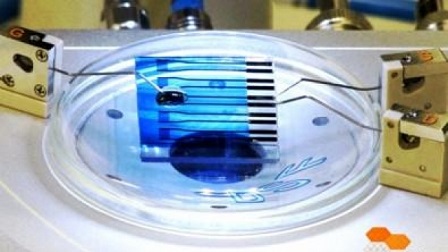 Cancer, along with most neurodegenerative diseases, are frequently not detected by an individual until they start experiencing symptoms of illness. By this time, the disease has begun to damage the body and it becomes increasingly hard to treat over time as it spreads. Pre-symptom tests are not 100% guaranteed either, as growths can easily be undetectable if they are not large enough or have grown too quickly. Researchers at the National Nanotechnology Laboratory (LNNano) in Campinas, Brazil, have created a disease detecting device so thorough in its inspection it can detect growths before they form.
Cancer, along with most neurodegenerative diseases, are frequently not detected by an individual until they start experiencing symptoms of illness. By this time, the disease has begun to damage the body and it becomes increasingly hard to treat over time as it spreads. Pre-symptom tests are not 100% guaranteed either, as growths can easily be undetectable if they are not large enough or have grown too quickly. Researchers at the National Nanotechnology Laboratory (LNNano) in Campinas, Brazil, have created a disease detecting device so thorough in its inspection it can detect growths before they form.
Capable of sensing specific molecules linked to Parkinson’s, Alzheimer’s, cancer, and other neurological diseases, this device can detect a disease before an individual shows any symptoms. Having a method of identifying an illness this early in their development will drastically increase a patient’s chances of beating it.
The device’s biosensor is a single-layer organic nanometer-scale on a glass slide containing a reduced form of peptide (small proteins) known as glutathione (GSH). When GSH comes into contact with a glutathione S-transferase (GST) enzyme, a substance linked with neurological diseases, a reaction occurs that is registered by the transistor. The biosensor is also very sensitive in detecting certain molecules and therefore could be altered to react to other disease substances besides the ones stated. This can be achieved by the user replacing the original peptides with a new substance that is known to react with the substance you are screening for.
The LNNano research team is currently looking into creating a system for rapid diagnosis out of functional material to produce simple sensors. These simple sensors could be used as quick scan, point-of-care devices, used in a variety of medical applications.
LLNano’s device is portable and inexpensive to manufacture, so it can used anywhere. Currently, researchers are looking to create a paper-base model of this biosensor to lower the overall cost even more and allow the device to be fully disposable. In order to achieve this, the team has created a polymerized paper which is able to make the paper conductive, enabling it to transport sensing data.
Intricate medical devices such as this biosensor require an efficient and reliable assembly process to produce high quality products to ensure maximum patient safety. Eclipse offers an abundance of health science solutions which can improve product quality and optimize your current operations.
Source: MDTMag
